Home > Auctions > 26 November - 1 December 2024
Ancient Art, Antiquities, Natural History & Coins
From a collection acquired on the UK art market from various auction houses and collections mostly before 2000.
From an important Cambridgeshire estate; thence by descent.
From a collection acquired on the UK art market from various auction houses and collections mostly before 2000.
From an important Cambridgeshire estate; thence by descent.
Property from the Upper East Side estate of M.H., New York, USA; a Slovak refugee who collected in the early 1980s.
Cf. Edlund, I.E.M., The Iron Age and Etruscan Vases in the Olcott Collection at Columbia University, New York, pp.28-29.
From the collection of Eleanor Hilowitz (1913-2007), an abstract expressionist painter and sculptor, New York, USA; acquired between 1956 and 1975.
Acquired by Randall Hixenbaugh of Hixenbaugh Ancient Art, New York, USA, in 2007.
with Artemis Gallery, 26 September 2019, lot 54 (US$2,000-3,000).
Property of a South Australian private collector, with collection reference 20.03.
Accompanied by detailed collector's catalogue pages including description and photograph.
Acquired in 2000.
Private collection, Europe.
UK private collection before 2000.
Acquired on the UK art market.
Property of a London gentleman.
From the collection of a gentleman, acquired on the London art market in the 1990s.
Cf. Shelton, K.J., The Esquiline Treasure, London, 1981, item 27, for type.
From the collection of Mr. F.U., Bavaria, acquired prior to 2000.
with Gorny & Mosch, 17 June 2015, no.303.
Accompanied by an academic report by Dr Raffaele D'Amato.
This lot has been checked against the Interpol Database of stolen works of art and is accompanied by a search certificate number no.12380-226601.
Cf. similar in the Cabinet Des Medailles, published in Rolley, C.I., Monumenta Graeca et Romana; volume V : Les arts mineurs grecs; fascicule 1: Les Bronzes, Paris, 1967, pl.30; Rolland, H., Bronzes Antiques de Haute Provence, XVIII supplément à ‘Gallia’, Paris, 1965, no.15.
From a collection acquired on the UK art market from various auction houses and collections mostly before 2000.
From an important Cambridgeshire estate; thence by descent.
See Mitten, D.G. & Doeringer, S.F., Master Bronzes of the Classical World, New York, 1968, pp.51-52, figs.33, 34, for type.
The small statuette is that of a naked youth, the so-called kouros, typical of archaic Greek sculpture of the 7th century B.C. Such representations underwent simplification in the early years of the 6th century B.C. with the Archaic smile transformed into something more akin to a grimace
Acquired from Faustus Ancient Art Ltd, London, 1990.
Private American collection.
with Christie’s, London, 27 October 2009, no 9.
Accompanied by copies of the relevant Christie's catalogue pages.
Accompanied by an academic report by Dr Raffaele D’Amato.
This lot has been checked against the Interpol Database of stolen works of art and is accompanied by a search certificate number no.12062-217441.
Cf. Torelli, M., Gli Etruschi, Monza, 2000, no.291, for a similar votive fictile head; Brøns, C., Skriver Hedegaard, S. and Sargent, M.L., ‘Painted Faces: Investigations of Polychromy on Etruscan Antefixes in the Ny Carlsberg Glyptotek’ in Etruscan Studies, 2016, 19 (1), pp.23-67, fig.17, for similar; cf. similar item with pigment in the British Museum under accession no.1893,0628.1.
The antefix belongs to the typical decorative scheme of alternating maenad and satyr head antefixes that were mainly produced in Cerveteri. Heads were often placed in temples and displayed identifying features such as wavy hair and large, almond-shaped lidded eyes, and were lavishly painted. These typologies of antefixes generally look quite similar and appear to have identical colour schemes with dark red skin, and with darker shades of red applied to the hair below the ears, on top of the head and inside the ears.
From a collection acquired on the UK art market from various auction houses and collections mostly before 2000.
From an important Cambridgeshire estate; thence by descent.
Cf. for the typology the bronze disc at the Metropolitan Museum, accession no.1991.171.60.
The round element represents the four-spoked wheel of a chariot, typical of the Bronze Age. The motif has been interpreted as solar symbolism since this period. The circularity between solar cosmologies—symbolic wheel/solar vehicle/functional chariot—was deeply ingrained since at least the 15th century from North Europe to Aegeaum, and continued in the early Iron Age.
with Petit Musée, Montreal, Canada, 1995.
Acquired Bonhams, London, 28 November 2017, lot 74.
Private collection of Professor Kenneth Graham, London, UK.
Accompanied by the original catalogue page and a copy of the original invoice.
Cf. Van Rooijen, G., Goddesses of Akragas, a study of terracotta votive figurines from Sicily, Leiden, 2021, nos.96, 163, for similar.
37 - 48 of 3419 LOTS

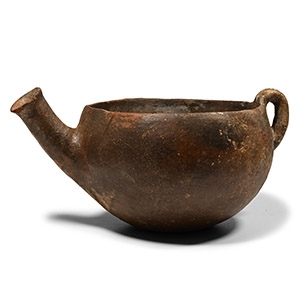

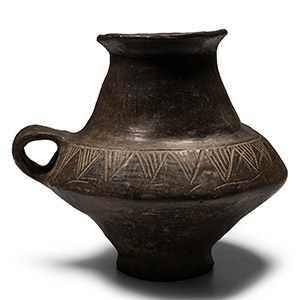
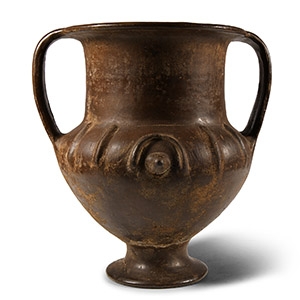

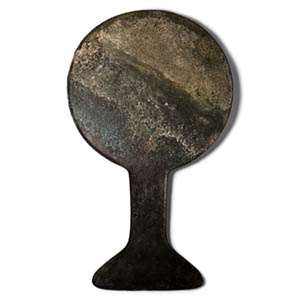
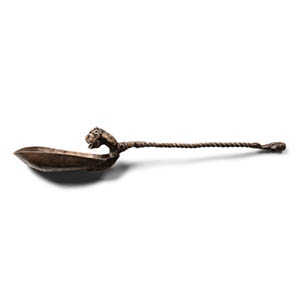




.jpg)



